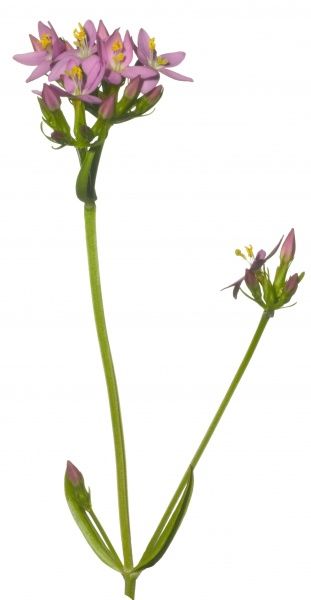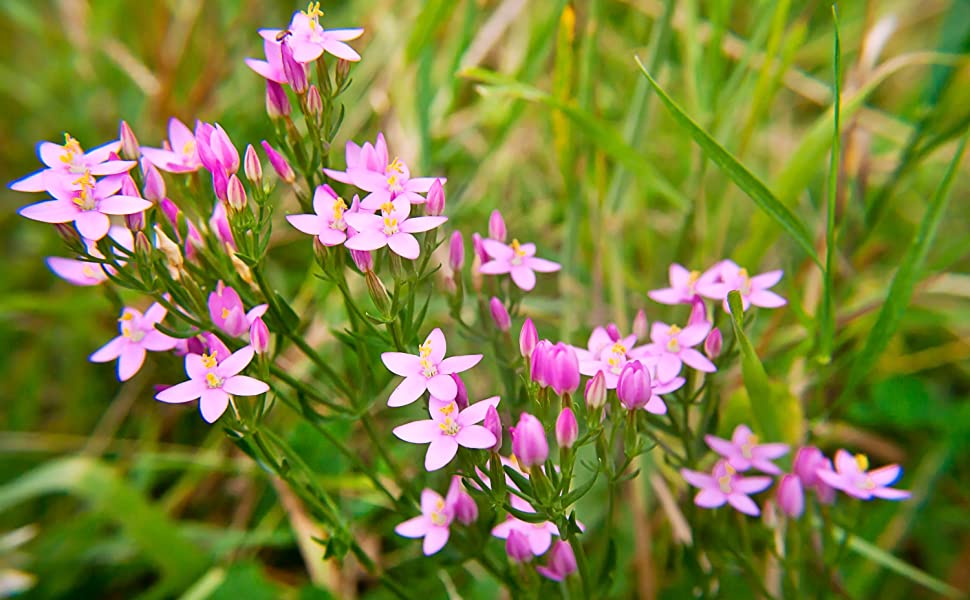Latin Name: Centaurium erythraea
Synonymn: Centaurium minus auct., C. minus auct. subsp. minus, C. umbellatum Gilib., Common Centaury, Erythraea centaurium (L.) Pers. subsp. centaurium
Other Names: Feverwort, Centaury Gentian, Filwort, Centory, Christ’s Ladder, Bitter Herb, Bitterbloom, Bitter Clover, Eyebright, Rose Pink, Wild Succory, Canchalagua
Habitat: The plant is found in the Mediterranean region and as far as Britain and Scandinavia. It is cultivated in the U.S.
Description of Centaury
Characteristics: Centaury has a very bitter taste.
Flower and Fruit: The different-sized flowers form a dense or loose cyme. They are purple to pink-red, seldom white. The calyx tube is pentangular with awl-shaped tips. There are 5 petals fused into a tube, 5 stamens mostly fused to the corolla and 1 superior, narrowly linear ovary. The stigma is 2-lobed. The fruit is a large, yellow, many-seeded capsule.
Leaves, Stem and Root: The plant is an annual that grows to between 5 and 30 cm high. The stem is erect, quadrangular and unbranched. The cauline leaves are crossed opposite, fleshy, oblong-ovate to lanceolate, and sessile. The basal leaves are rosette-like, obovate and narrowed to a petiole.
Constituents
The following is compiled from several sources:
Acids: Phenolic – Protocatechuic, m- and p-hydroxybenzoic, vanillic, syringic, p-coumaric, ferulic, sinapic and caffeic, hydro-xyterephthalic and 2,5-dihydroxyterephthalic acids among others.
Alkaloids: Pyridine-type – Traces of gentianine, gentianidine, gentioflavine and others.
Monoterpenoids: Iridoids (bitters) – Gentiopicroside (about 2%) as major, others include centapicrin, gentioflavoside, sweroside and swertiamarin; intensely bitter m-hydroxybenzoylesters of sweroside and catapicrin.
Triterpenoids: Includes a- and b-amyrin, erythrodiol, crataegolic acid, oleanolic acid and sitosterol. Xanthones Highly methylated xanthones, including eustomin and 8-demethyleustomin.
Other constituents: Flavonoids, fatty acids, alkanes and waxes.
Action
Tonic-hepatic, mild sedative, febrifuge, astringent (topical), bitter tonic, analgesic (mild), anti-inflammatory, antipyretic.
Medicinal Parts
The medicinal parts are the dried, aerial parts of the flowering plant.
Food Use
Centaury is listed by the Council of Europe as a natural source of food flavouring (category N2). This category indicates that centaury can be added to foodstuffs in small quantities, with a possible limitation of an active principle (as yet unspecified) in the final product. Previously, the bitter properties of centaury were utilised in alcoholic and non-alcoholic beverages with maximum permitted doses between 0.0002% and 0.0008%.
Herbal Use
Centaury is reputed to act as a bitter, aromatic and stomachic. Traditionally, it has been used for anorexia and dyspepsia, weak or ‘sour’ stomach, heartburn, nausea, vomiting, indigestion, liver disorders (mild), hypertension, kidney stone, skin blemishes, freckles (lotion), wound healing, tapeworm.

Preparation and dosage
Preparations: Thrice daily.
Tea: Half teaspoon to each cup boiling water; infuse 15 minutes. Half-1 cup.
Liquid extract BHP (1983): 1:1 in 25 per cent alcohol. Dose: 2-4ml.
Tincture: 1 part Centuary herb to 20 parts Vodka; macerate 8 days. Dose: 1 wineglassful for liver and gallbladder. (Russian traditional)
Tapeworm: tea taken daily 2-3 months.
Combination: Equal parts, Centuary, Chamomile and Meadowsweet (tea). 1 heaped teaspoon to each cup boiling water: 1 cup thrice daily.
Side-effects, Toxicity
There is a lack of clinical safety and toxicity data for centaury. An alcoholic extract of centaury (200 mL/plate) was antimutagenic in Salmonella typhimurium strains TA8 and TA100.
Contra-indications, Warnings
Centaury is contra-indicated for individuals with peptic ulcers.
Drug interactions
None documented. However, the potential for preparations of centaury to interact with other medicines administered concurrently, particularly those with similar or opposing effects, should be considered.
Pregnancy and lactation
The safety of centaury taken during pregnancy has not been established. In view of the lack of toxicity data, use of centaury during pregnancy and lactation should be avoided.
Reference(s)
Herbal Medicines, Third Ed. by Joanne Barnes BPharm, PhD, MRPharmS, RegPharmNZ, MPSNZ, FLS
Bartram’s Enclopedia of Herbal Medicine by Thomas Bartram
This article is copyrighted by Ital is Vital, 2025. Want to re-post this article? Visit our guidelines.
DISCLAIMER: THIS WEBSITE DOES NOT PROVIDE MEDICAL ADVICE
The information, including but not limited to, text, graphics, images and other material contained on this website are for informational purposes only. The purpose of this website is to promote broad consumer understanding and knowledge of various health topics. It is not intended to be a substitute for professional medical advice, diagnosis or treatment. Always seek the advice of your physician or other qualified health care provider with any questions you may have regarding a medical condition or treatment and before undertaking a new health care regimen, and never disregard professional medical advice or delay in seeking it because of something you have read on this website.
